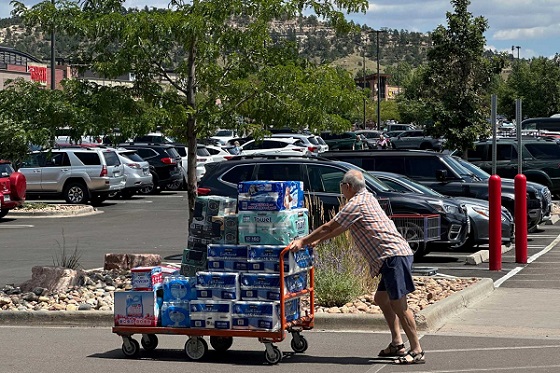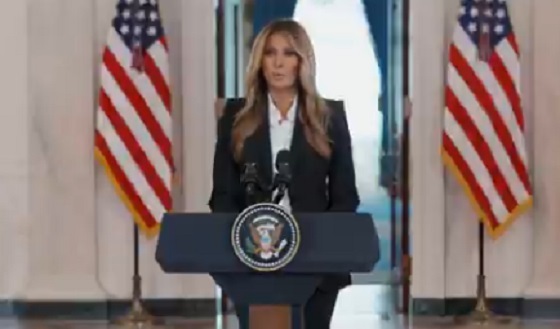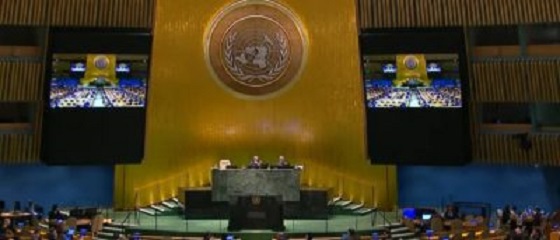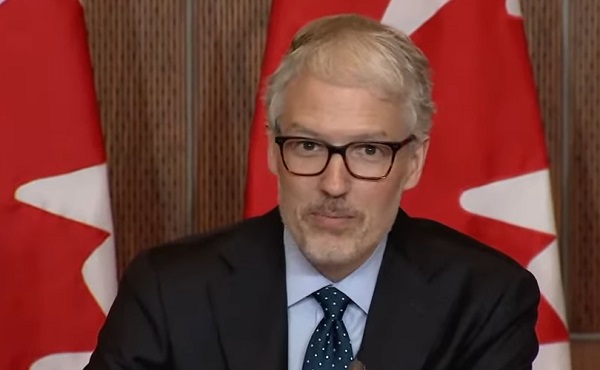Opinion
When black roofs cost more and most negatively affect our health, why are we installing them?

We are into construction season and summer and the heat is starting to be an issue. We will have some heat waves and we will notice the “Urban Heat Island Effect”.
The city will seem hotter than the county, but we will also notice differences in temperature between light coloured vehicles and darker coloured vehicles, and even the coolness of a white fence.
During heat waves some of the most vulnerable people are those living on the top floor of a building with a black roof.
My biggest question is why are we still putting black roofs on our buildings? Black roofs do not absorb heat in the winter under a foot of white snow. They absorb heat during the hot days making it hotter.
Let’s start at the beginning, by hitting the Google button.
What is the Heat Island Effect?
The elevated temperature in urban areas as compared to rural, less developed areas is referred to as the urban heat island effect. As cities grow and develop, more buildings and people are added. The process of urban development leads to this phenomenon.
What are the Implications of Heat Islands?
Heat islands are considered a form of local climate change as opposed to global climate change. The effects of heat islands are confined to specific areas, and do not have a larger impact on climate change. Despite being confined to a certain locality, heat islands can still make a significant impact.
Of course, one of the most noticeable impacts on urban dwellers is an increase in hot, summer weather. On particularly clear and hot days, when the heat island effect is at its worst, inhabitants of larger cities will notice hotter and more uncomfortable temperatures. When people are hot, they often crank up their air conditioners. Increases in air conditioning use not only results in more heat being released into the air, this also contributes to air pollution, as more greenhouse gas emissions are discharged. This negatively impacts air quality and can also lead to a surge in urban smog.
How Can We Reduce the Heat Island?
Since the impact of heat islands is mostly negative, scientists and researchers are searching for ways to reduce and reverse the effects. Dark roof surfaces are one of the major culprits of temperature increases. One popular technique for combating the heat island effect is installing green roofs on urban buildings. Green roofs, which are lined with soil and certain types of vegetation, can actually help cities regain some of the cooling and evaporative effects that the natural landscape once provided. As this idea becomes more popular, there is more and more scientific evidence that green roofs can reduce heat in urban areas.
Dark building surfaces that absorb more heat account for some of the rising temperatures in urban areas. One simple method for reducing this effect is to paint buildings with light or white colors that do not absorb nearly as much heat. Some cities are also using paint treatments that reflect light to combat the heat island effect. White, Green or Black Roofs? Berkeley Lab Report Compares Economic Payoffs
Looking strictly at the economic costs and benefits of three different roof types—black, white and “green” (or vegetated)—Lawrence Berkeley National Laboratory (Berkeley Lab) researchers have found in a new study that white roofs are the most cost-effective over a 50-year time span. While the high installation cost of green roofs sets them back in economic terms, their environmental and amenity benefits may at least partially mitigate their financial burden.
A new report titled “Economic Comparison of White, Green, and Black Flat Roofs in the United States” by Julian Sproul, Benjamin Mandel, and Arthur Rosenfeld of Berkeley Lab, and Man Pun Wan of Nanyang Technological University in Singapore, provides a direct economic comparison of these three roof types. The study will appear in the March 2014 volume of Energy and Buildings and has just been published online. “White roofs win based on the purely economic factors we included, and black roofs should be phased out,” said study co-author Rosenfeld, a Berkeley Lab Distinguished Scientist Emeritus and former Commissioner of the California Energy Commission
The study analyzes 22 commercial flat roof projects in the United States in which two or more roof types were considered. The researchers conducted a 50-year life cycle cost analysis, assuming a 20-year service life for white and black roofs and a 40-year service life for green roofs.
A green roof, often called vegetated roofs or rooftop gardens, has become an increasingly popular choice for aesthetic and environmental reasons. Rosenfeld acknowledges that their economic analysis does not capture all of the benefits of a green roof. For example rooftop gardens provide storm water management, an appreciable benefit in cities with sewage overflow issues, while helping to cool the roof’s surface as well as the air. Green roofs may also give building occupants the opportunity to enjoy green space where they live or work.
Berkeley Lab Distinguished Scientist Emeritus Art Rosenfeld
“We leave open the possibility that other factors may make green roofs more attractive or more beneficial options in certain scenarios,” said Mandel, a graduate student researcher at Berkeley Lab. “The relative costs and benefits do vary by circumstance.”
However, unlike white roofs, green roofs do not offset climate change. White roofs are more reflective than green roofs, reflecting roughly three times more sunlight back into the atmosphere and therefore absorbing less sunlight at earth’s surface. By absorbing less sunlight than either green or black roofs, white roofs offset a portion of the warming effect from greenhouse gas emissions.
“Both white and green roofs do a good job at cooling the building and cooling the air in the city, but white roofs are three times more effective at countering climate change than green roofs,” said Rosenfeld.
White roofs are most cost-effective
The costs and benefits difference stack that has the highest net present value shows the roof type that is most cost-effective.
The 50-year life-cycle cost analysis found that even the most inexpensive kind of green roof (with no public access and consisting of only sedum, or prairie grass) costs $7 per square foot more than black roofs over 50 years, while white roofs save $2 per square foot compared to black roofs. In other words, white roofs cost $9 per square foot less than green roofs over 50 years, or $0.30 per square foot each year.
The researchers acknowledge that their data are somewhat sparse but contend that their analysis is valuable in that it is the first to compare the economic costs and energy savings benefits of all three roof types. “When we started the study it wasn’t obvious that white roofs would still be more cost-effective over the long run, taking into account the longer service time of a green roof,” Mandel said.
Furthermore while the economic results are interesting, it also highlights the need to include factors such health and environment in a more comprehensive analysis. “We’ve recognized the limitations of an analysis that’s only economic,” Mandel said. “We would want to include these other factors in any future study.”
Black roofs pose health risk
For example, black roofs pose a major health risk in cities that see high temperatures in the summer. “In Chicago’s July 1995 heat wave a major risk factor in mortality was living on the top floor of a building with a black roof,” Rosenfeld said.
For that reason, he believes this latest study points out the importance of government policymaking. “White doesn’t win out over black by that much in economic terms, so government has a role to ban or phase out the use of black or dark roofs, at least in warm climates, because they pose a large negative health risk,” he said.
Rosenfeld, who started at Berkeley Lab in the 1950s, is often called California’s godfather of energy efficiency for his pioneering work in the area. He was awarded a National Medal of Technology and Innovation by President Obama in 2012, one of the nation’s highest honours.
Rosenfeld has been a supporter of solar-reflective “cool” roofs, including white roofs, as a way to reduce energy costs and address global warming. He was the co-author of a 2009 study in which it was estimated that making roofs and pavements around the world more reflective could offset 44 billion tons of CO2 emissions. A later study using a global land surface model found similar results: cool roofs could offset the emissions of roughly 300 million cars for 20 years.
So if black roofs are detrimental to our health, contribute to the issue of Urban Heat Island Effect and costs more, why are we still building black roofs?
Media
Canada’s top Parliamentary reporters easily manipulated by the PMO’s “anonymous sources”
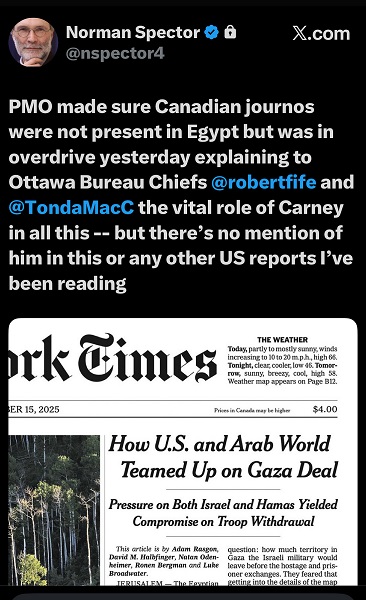
X-post by former PMO chief of staff Norman Spector, who noticed something was up concerning how the Prime Minister’s team got its message out
Press Gallery members denied access to Carney’s Egypt photo opportunity dutifully repeat anonymous, unverified claims elevating the Prime Minister’s importance
Last week, the Parliamentary Press Gallery (PPG) and I had something in common.
We were both dismayed.
They, because they weren’t invited to join Prime Minister Carney on his last-minute trip to Egypt for a photo opp; Me because most of them didn’t seem all that interested in looking into the circumstances of the PM’s hasty departure and instead allowed themselves to be played in the most appallingly obvious manner.
Peter Menzies is a past publisher of the Calgary Herald, a former vice chair of the CRTC and a National Newspaper Award winner.
Subscribe to The Rewrite.
What got the PPG’s knickers twisted was that they weren’t invited to accompany Carney when he departed Ottawa in a rush to get to the Egyptian resort of Sharm El Sheikh, a popular spot on the Red Sea for the world’s glitterati. It took PPG President Mia Rabson a couple of days to issue a statement, but she made it clear the PPG disapproved:
“The Parliamentary Press Gallery was not informed in advance of the Prime Minister’s trip to Egypt to participate in the Middle East Peace Ceremony on Oct. 12 -13,” she wrote. “The Gallery is disappointed and dismayed at the exclusion of Canadian media from the event and expresses in no uncertain terms that this must never happen again.
“It is unprecedented that Canadian media be entirely excluded from a Canadian prime minister’s foreign trip.”
The only reporting I could find on this was in Politico, where it was recorded that the PMO had posted this notice: “6:30 p.m. The Prime Minister will depart for Sharm el-Sheikh, Egypt, to attend the signing of a Middle East peace plan. Closed to media.”
What first caused my jaw to drop and to become, like Rabin, disappointed and dismayed, were the stories left unpursued. On the morning of Oct. 12, Canada was not listed as among the countries invited to join in the “peace summit” associated with the ceasefire deal reached between Israel and Hamas. If it had been, the prime minister may not have had to charter a private jet because the usual Royal Canadian Air Force planes and crews were, as City News’s Glen MacGregor reported, unavailable.
There are two lines of journalistic inquiry there, neither of which appears to have been of interest. The first is: how can Canada’s military be so poorly equipped that there isn’t at all times a fully-equipped aircraft and crew on standby and is this an issue that will be addressed in the future? The second is: how did we wind up getting invited to the peace summit? Comments by US President Donald Trump indicate that we weren’t initially considered important enough to be on site but phoned to ask if we could join the party. (The Line – which doesn’t accept government subsidies – noticed.)
Trump, in remarks to media said: “You have Canada. That’s so great to have, in fact. The president called and he wanted to know if it’s worth – well he knew exactly what it is. He knew the importance. Where’s Canada, by the way? Where are you? He knew the importance of this.”
What was pursued, at least in comments online by journalists, was Trump’s inability to identify Carney by his correct title. (In an exchange that followed, Carney sarcastically thanked Trump for elevating him and, in response, was told “at least I didn’t call you governor.” Ha ha.)
Everyone is free to make their own decisions, but if Canada had to call Trump to ask to be invited, Canadians need to know if that means we are in the president’s debt. Trump, after all, seems like the sort of guy who keeps score.
Readers will notice a new DONATE button has been added.
This allows you to buy The Rewrite a cup of coffee or, if you are feeling generous, wine, but doesn’t constitute a subscription.
Please consider making use of it and help us save journalism from bad journalism.
Share
But it’s what followed that really got creepy. While Canadian reporters were not allowed to accompany the prime minister to Egypt, someone who says he or she was on the plane started phoning around to tell reporters what happened. And they went for it. The Globe and Mail, Toronto Star and Politico all reported unverified statements emanating from a single, unnamed source. The Globe’s Robert Fife reported that “a senior government official” said that while Carney and others thought they were just in Egypt for a photo opp, during a four hour wait for Trump to arrive from Israel “Mr. Carney had back-and-forth conversations with a group of leaders.”
Fife wrote that “The Globe and Mail is not identifying the official so they could speak candidly.”
Tonda MacCharles of the Toronto Star also quoted a “senior Canadian government official” who “spoke confidentially to provide background information on what was discussed at the leaders-only talks.” Said official was buzzing about the dynamism of the occasion and the ever so important role the boss played at the photo opp.
“Imagine the G20 without the talking points and pomp and circumstance. We all came out of it, staffers, like ‘wow that was a useful meeting,’” the anonymous source told MacCharles, whose report, similar to Fife’s, did not indicate that any efforts whatsoever had been made to verify the claims of the “official” with even a second anonymous “official.”
The Globe report expanded on how Carney’s attendance in Egypt was all part of a broader strategy, that he is well-known and liked in the region and how the invitation “was not a surprise” because Carney has “sought” to “act as a go-between Arab states and Washington.”
That doesn’t exactly appear consistent with the source’s concession that Carney’s office “first heard of the invitation on social media” but, whatever.
MacCharles and Fife tried to add greater context to their reports (the former doing the better job, in my view) but while The Free Press’s Rupa Subramanya wondered what all the fuss was about and Brian Mulroney’s former chief of staff Norman Spector (see frame grab above) smelled a rat, my conclusion is that what we have here is unacceptable.
The Prime Minister departed the country unaccompanied by even a single representative of the nation’s press. Upon his return, neither Carney nor any “officials” held a news conference to explain what took place. Instead, targeted media got fed what could be (I’ll use the polite term) pure fantasy. Two of Canada’s leading news organizations, apparently confusing themselves with stenographers, then – and without noting any attempts whatsoever at verification – dutifully passed it all along to their readers on …. faith.
Compare what took place here to what the Associated Press has to say about the use of anonymous sources in politics:
“No one wants news that’s built on unnamed, unaccountable sources and facts seemingly pulled from the air. Politicians and members of the public sometimes have cited such journalism as a reason for the fall in trust in the media….
“Reporting with loose attribution or anonymous sourcing can be dismissed as fake by the skeptical reader or politician. On the other hand, a report filled with verifiable facts attributed to named and authoritative sources of information is impossible to dispute.”
When all was said and done, the coverage of the Prime Minister’s visit to Egypt was denied to journalists and replaced with unchallenged reports from the leader’s staff, just like it’s done in tin pot dictatorships. And not a peep from the nation’s heavily subsidized journalism community.
Not a frickin’ peep.
(Peter Menzies is a commentator and consultant on media, Macdonald-Laurier Institute Senior Fellow, a past publisher of the Calgary Herald, a former vice chair of the CRTC and a National Newspaper Award winner.)
Readers will notice a new DONATE button has been added. This allows you to buy The Rewrite a cup of coffee or, if you are feeling generous, wine, but doesn’t constitute a subscription. Please consider making use of it and help us save journalism from bad journalism.
Subscribe to The Rewrite.
For the full experience, upgrade your subscription.
espionage
“Suitcase of Cash” and Secret Meeting Deepen Britain’s Beijing Espionage Crisis
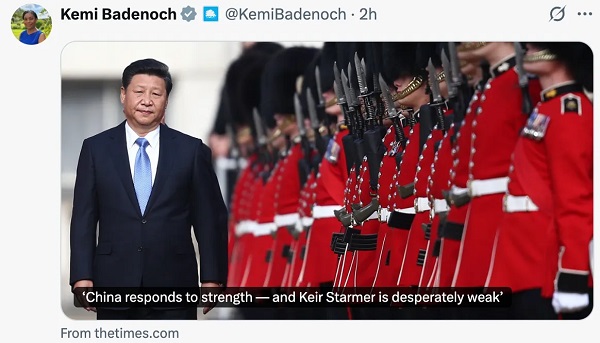
Britain’s most consequential espionage scandal in a generation has narrowed on Keir Starmer’s inner cabinet after The Sunday Times revealed that alleged Chinese agent Christopher Berry was intercepted at Heathrow Airport with a “suitcase full of cash” — and that senior officials, including National Security Adviser Jonathan Powell and Cabinet Secretary Christopher Wormald, held a closed-door meeting, allegedly discussing that advancing the case would harm relations with Beijing, weeks before prosecutors abandoned the insider-threat file.
The revelations, combined with an explosive Opposition letter from Kemi Badenoch and a rare diplomatic intervention from Washington, have plunged Prime Minister Keir Starmer’s government into the most serious national-security controversy of its tenure — one now shaking both Westminster and the Five Eyes intelligence alliance. Not since the Kim Philby affair and the exposure of the Cambridge Spy Ring has a British government been so roiled by allegations of insider compromise and appeasement toward a hostile foreign state.
As The Sunday Times reported, Christopher Berry — a 33-year-old academic from Oxfordshire — was stopped under the Terrorism and Border Security Act after a February 2023 flight from China. Police seized £4,000 in cash, believed to have been supplied by his Chinese handler, codenamed “Alex,” linked to the Ministry of State Security.
A witness statement tabled in Parliament last week indicated that Berry funnelled real-time political intelligence through his MSS handler to one of Beijing’s senior leaders, all collected from a former Chinese teaching colleague — a Parliamentary researcher with deep access to senior Conservative MPs. Beijing reportedly viewed those MPs as a strategic threat, fearing that if they rose to higher office they would adopt a far stricter stance toward China’s geopolitical ambitions.
Though Berry was not detained at the time, the incident became central to the espionage case later dropped by the Crown Prosecution Service when the Starmer government declined to certify that China posed an “ongoing threat to national security” — a legal requirement under the Official Secrets Act.
The Sunday Times also revealed that Deputy National Security Adviser Matthew Collins, the government’s sole witness, privately acknowledged that the decision not to describe China as an “ongoing threat” was “political.” The paper further disclosed that Jonathan Powell — a former banking executive who rose to become Starmer’s National Security Adviser — chaired a meeting on September 1 attended by Cabinet Secretary Christopher Wormald and MI5 Director-General Sir Ken McCallum, in which “the general theme of discussion was how the UK’s relationship with China was going to be damaged by this case.”
If accurate, that account directly contradicts Starmer’s assurance to Parliament that “no minister or special adviser was involved.” The implication — that Britain’s most senior national-security officials were weighing diplomatic consequences while an active espionage prosecution was still underway — has intensified accusations that the case was derailed by political interference rather than evidentiary weakness.
Within hours of the Sunday Times story, Opposition Leader Kemi Badenoch posted a letter to X accusing Keir Starmer of misleading Parliament and concealing ministerial involvement in the case’s collapse.
Framing the letter, Badenoch sought to explain the rapidly evolving affair to a wider audience. “I don’t blame you if you’ve struggled to follow the China spying case engulfing Parliament. Even MPs are finding it hard to keep up with a story that seems to change by the hour,” she wrote. “I suspect many fair-minded people have assumed this story can’t contain much. It seems too implausible for the government to have deliberately let off people who were accused of spying on MPs. But the story is truly astonishing. The layers of it have unravelled over the past few weeks like something from a spy novel.”
In the letter itself, Badenoch demands full disclosure of all correspondence, meetings, and witness-statement revisions involving Jonathan Powell, the Attorney General, or the Cabinet Office. She references the Sunday Times account directly, noting that “Powell left attendees with the understanding that Deputy National Security Adviser Collins’s witness statement would operate within the language of the report,” implying foreknowledge and coordination between Downing Street and prosecutors. She further alleges that Starmer’s ministers “softened” later witness statements to downplay Chinese espionage, replacing hard intelligence assessments with diplomatic phrasing designed to reassure Beijing. Her conclusion is cutting: “You have shown Britain is weak in the face of espionage, and have emboldened our enemies to believe they can spy on us with impunity.”
As reported previously by The Bureau, the controversy has now drawn international concern. The Chair of the U.S. House Select Committee on the Chinese Communist Party, John Moolenaar, has issued an extraordinary public rebuke on the court matter — a move almost without precedent between close allies. In a two-page letter dated October 16, 2025, addressed to James Roscoe, chargé d’affaires at the British Embassy in Washington, Moolenaar warned that Britain’s decision to abandon the prosecution risked setting “a dangerous precedent that foreign adversaries can target democratically elected legislators with impunity.” He wrote that the decision “deeply troubles” U.S. lawmakers and “undermines Five Eyes security coordination,” given the substantial amount of evidence against Berry and Christopher Cash, who were accused of funnelling parliamentary intelligence to the Chinese Communist Party.
“I hope the UK government will not allow this case to falter,” Moolenaar said, “and will instead take the steps necessary to ensure that both justice and due process are served.”
The letter, co-signed by senior members of the Committee and publicly released by Congress, marks an exceptional public intervention in a live national-security case involving a Five Eyes partner. Moolenaar added that the decision to drop the prosecution — despite evidence confirming a direct intelligence channel from Westminster to Beijing — “paints a concerning picture,” noting the resumption of high-level UK–China trade talks, negotiations over China’s proposed “super embassy” in London, and London’s ongoing review of its diplomatic posture toward Beijing. “Allowing this PRC aggression to go unchecked,” he warned, “would only incentivize the CCP to further interfere in Western democracies.”
As The Bureau previously detailed, Matthew Collins’s witness statement traced an intelligence pipeline connecting Westminster directly to Beijing’s leadership. Berry, via his handler “Alex,” transmitted reports obtained from Christopher Cash, a parliamentary aide with access to Conservative MPs critical of Beijing. Collins confirmed that some of the same intelligence later appeared in the possession of a senior CCP Politburo Standing Committee member — reportedly Cai Qi, one of Xi Jinping’s closest allies. Collins also documented Beijing’s targeted inquiries into the 2022 Conservative leadership race, focusing on Tom Tugendhat and Neil O’Brien, both members of the China Research Group (CRG) and long-standing critics of the CCP.
Taken together, the Heathrow cash seizure, the Powell-chaired meeting, the Badenoch letter, and the U.S. congressional intervention point to a modern Cold War crisis — a confrontation that has now moved beyond Westminster to test the cohesion of the Western alliance itself.
The Bureau is a reader-supported publication.
To receive new posts and support my work, consider becoming a free or paid subscriber.
-
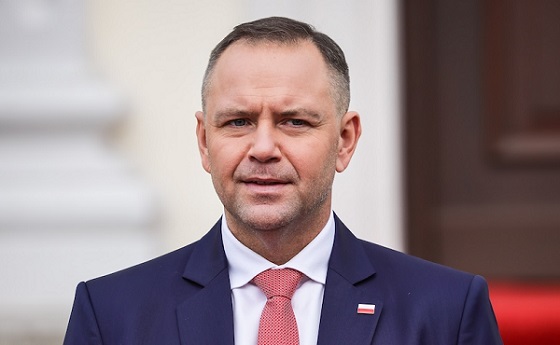
 International1 day ago
International1 day agoPoland’s president signs new zero income tax law for parents with two children
-

 Business2 days ago
Business2 days agoFederal Budget 2025: A responsible media would ensure Canadians know about the dismal state of federal finance
-
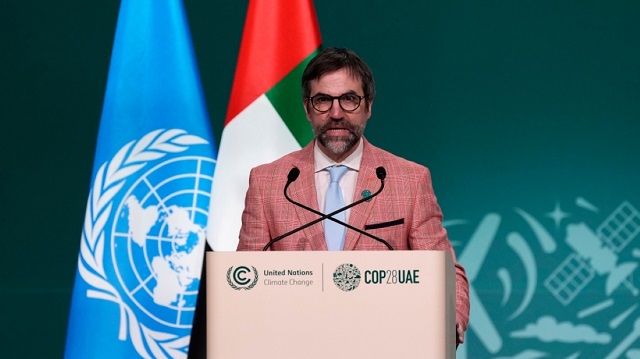
 Business2 days ago
Business2 days agoCanada has an energy edge, why won’t Ottawa use it?
-
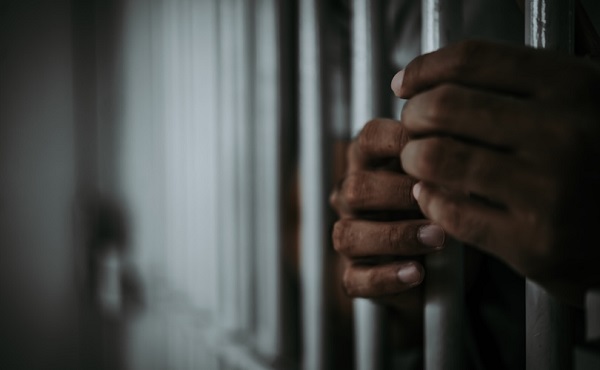
 International1 day ago
International1 day agoAustralian territory bans men from women’s prisons in national first
-
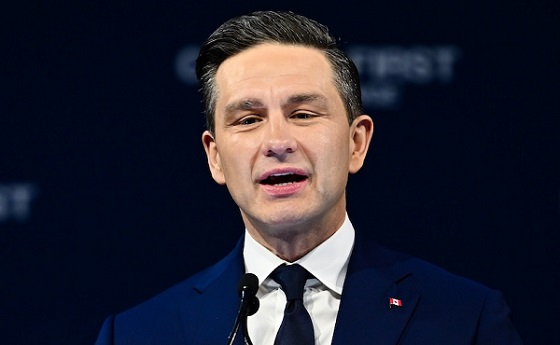
 National1 day ago
National1 day agoPoilievre accuses Canada’s top police force of ‘covering up’ alleged Trudeau crimes
-
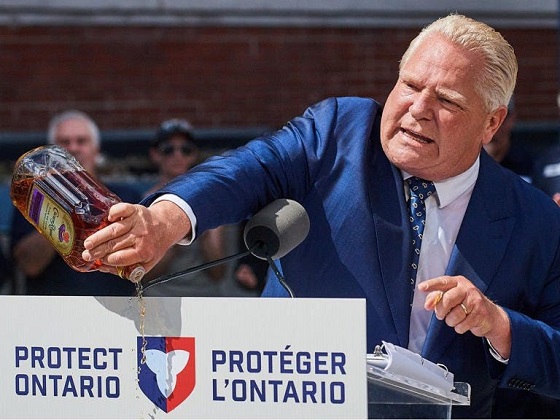
 Business1 day ago
Business1 day agoFord’s Whisky War
-
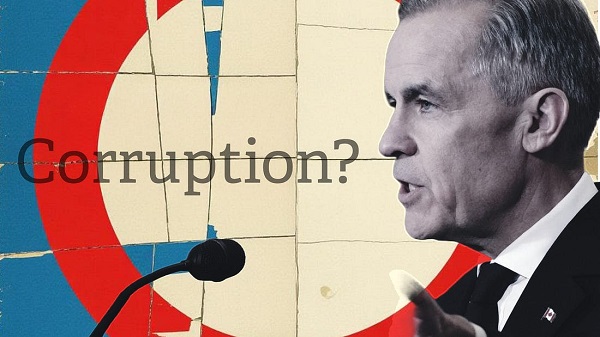
 Business2 days ago
Business2 days agoEthics on Ice: See You Next Year
-

 Alberta2 days ago
Alberta2 days agoDiploma Exams Affected: No school Monday as ATA rejects offer of enhanced mediation




